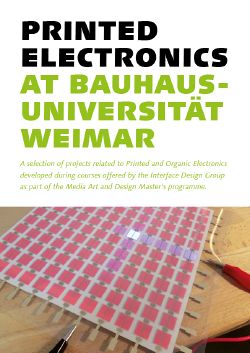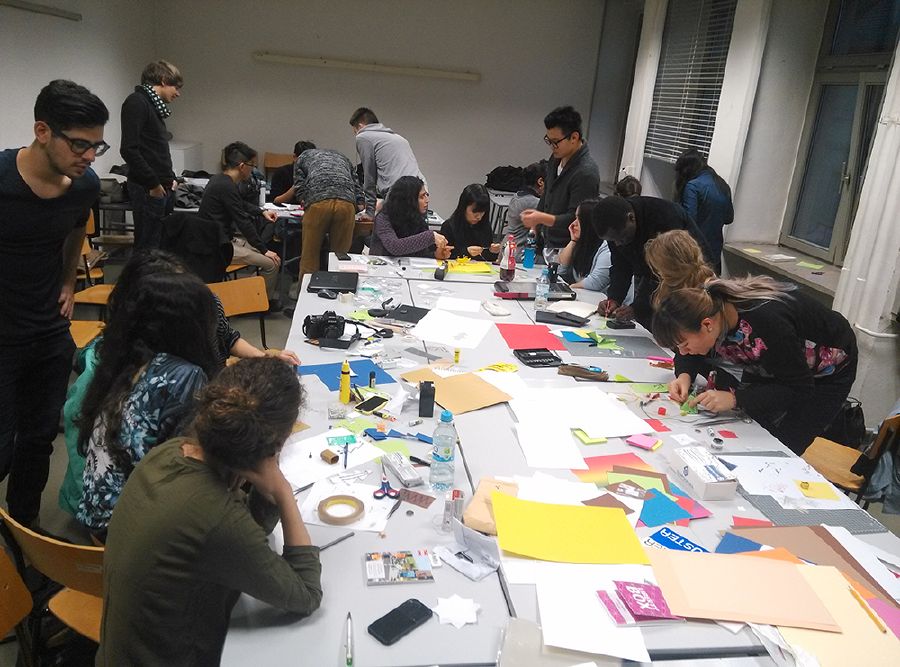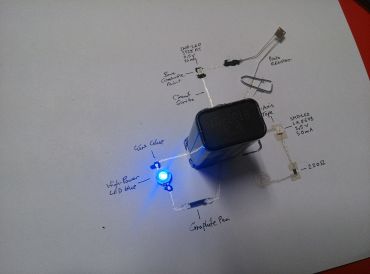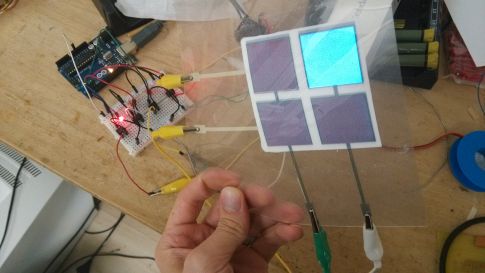No edit summary |
No edit summary |
||
| (24 intermediate revisions by the same user not shown) | |||
| Line 1: | Line 1: | ||
[[File:PrintedElectronics_Dokumentation.pdf | [[File:PrintedElectronics_Dokumentation_cover.jpg|250px|left|link=https://www.uni-weimar.de/kunst-und-gestaltung/wiki/images/PrintedElectronics_Dokumentation.pdf]] | ||
'''Printed Electronics at Bauhaus Universität Weimar: Selected Projects''' | |||
[https://www.uni-weimar.de/kunst-und-gestaltung/wiki/images/PrintedElectronics_Dokumentation.pdf Download: Project Documentation (PDF)] | |||
The selected projects introduced in this document were developed during the Printed Electronics courses (Fachmodul/Werkmodul) supervised by Florian Wittig. The courses were offered in 2016 and 2017 by the Interface Design Group as part of the Media Art and Design Master‘s and Bachelor’s programme. | The selected projects introduced in this document were developed during the Printed Electronics courses (Fachmodul/Werkmodul) supervised by Florian Wittig. The courses were offered in 2016 and 2017 by the Interface Design Group as part of the Media Art and Design Master‘s and Bachelor’s programme. | ||
| Line 5: | Line 9: | ||
During the duration of one semester, students should be able to get a basic understanding of the technology of printed electronics. In classroom sessions the basic qualities and possibilities of printed electronics were explored, as well as the characteristics of the tools used later on. During so-called prototyping sessions the students then had the opportunity to experiment and combine printed circuits with electronic components. For this purpose, materials such as different types of paper, electronic components such as LEDs and measuring tools like multimeters were provided. In the final phase of the course, each of the students developed their own personal project, depending on the predefined subject of the course. | During the duration of one semester, students should be able to get a basic understanding of the technology of printed electronics. In classroom sessions the basic qualities and possibilities of printed electronics were explored, as well as the characteristics of the tools used later on. During so-called prototyping sessions the students then had the opportunity to experiment and combine printed circuits with electronic components. For this purpose, materials such as different types of paper, electronic components such as LEDs and measuring tools like multimeters were provided. In the final phase of the course, each of the students developed their own personal project, depending on the predefined subject of the course. | ||
[[File:prototyping01.jpg| | <br /> | ||
[[File: | [[File:prototyping01.jpg|900px]] | ||
[[File: | <br /> | ||
[[File:printed_electronics_study_IMG_20161122_042447.jpg|370px]] | |||
[[File:EL_test_IMG_20151016_034239.jpg|485px]] | |||
Latest revision as of 15:24, 12 September 2018
Printed Electronics at Bauhaus Universität Weimar: Selected Projects
Download: Project Documentation (PDF)
The selected projects introduced in this document were developed during the Printed Electronics courses (Fachmodul/Werkmodul) supervised by Florian Wittig. The courses were offered in 2016 and 2017 by the Interface Design Group as part of the Media Art and Design Master‘s and Bachelor’s programme.
During the duration of one semester, students should be able to get a basic understanding of the technology of printed electronics. In classroom sessions the basic qualities and possibilities of printed electronics were explored, as well as the characteristics of the tools used later on. During so-called prototyping sessions the students then had the opportunity to experiment and combine printed circuits with electronic components. For this purpose, materials such as different types of paper, electronic components such as LEDs and measuring tools like multimeters were provided. In the final phase of the course, each of the students developed their own personal project, depending on the predefined subject of the course.



